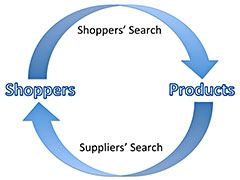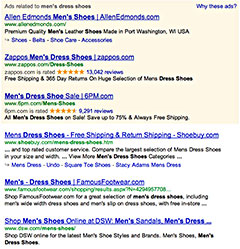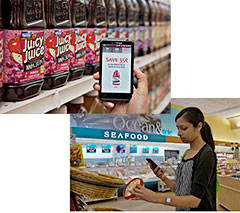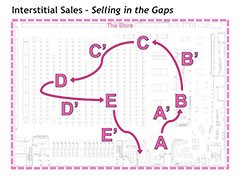|
"Googling" the Store We have documented repeatedly that shoppers waste as much as 80% of their time in the store, and this wasted time represents the potential for large increases in sales for those who learn to leverage it, whether retailers or their suppliers. We have also noted that the principle time wasters for the shopper are decisions/information seeking:
Here we call attention to how the online Google process is relevant to the process of shopping in a bricks-and-mortar store. After all, the in-store shopping process IS all about search. This is NOT about using online search to assist bricks purchases, at least in the initial concept discussed here. Several years ago, I introduced the concept of the "Amazonification of Walmart," based on Wharton Professor Peter Fader's observation to me that the path of the shopper through a store (their in-store "clickstream,") was analogous to their online purchase clickstream. This was the doorway to proper thinking about in-store selling, and particularly to the relation of the big head merchandise — those few items shoppers are most interested in purchasing, to the long tail items — those tens of thousands of items that sell very little, but exert a powerful force in attracting shoppers to the store. Shoppers "Googling" the Store This should be no surprise, since shoppers of course already "Google" when they are planning to buy something, or research something, online. Amazon is not the only retailer with online search capabilities, although the quality and convenience of that searching is often vastly inferior to that provided by Amazon on their online site. (Of course, Google also has a shopping service.) The point here is that searching for what is wanted is THE basic feature of all shopping, so it is a no-brainer that a search company would be in the shopping business. But the Amazon search engine is probably orders of magnitude superior to anyone else's, as noted in "Efficiency & Convenience..." "We used to joke that the ideal Amazon site would not show a search box, navigation links, or lists of things you could buy. Instead, it would just display a giant picture of one book, the next book you want to buy." This shows that Amazon, as good as they are at search, is driven by commercial considerations to make the search productively successful — complete the sale — immediately, if not sooner. Until other retailers catch on to this principle, they will continue to have their lunches eaten by Amazon, at Amazon's leisure. The point here is that when shopping, shoppers do not search because they like to search, but because there is a barrier between them and what they need or want to purchase. It's sad that there are people in sales and marketing (hopefully your competitors, ;-) who actually think that if they can make the search (aka shopping,) longer and more pleasurable, they will sell more! Tsk, tsk! Selling is always about the close, and the sooner the better. Retailers or Suppliers "Googling" the Shoppers! Once we have it well settled in mind that shopping involves searching for products — paths and items — we are prepared to look at the two sides of this search:
That's right, in the store, whether online or bricks, the search is bidirectional: 
Shoppers look for products, and products (suppliers/retailers) look for shoppers. How this bidirectional search happens online is illustrated by a standard Google search for something like "men's dress shoes." (Google came up with 37 million results for the search — how's THAT for a "long tail?") 
Notice that the top three listings are identified as "Ads related to men's dress shoes." Another way of saying this is that these three listings represent someone, the advertiser, who is looking for people who are looking for men's dress shoes. This is the reverse search, and of course those three listings, in first, second and third order, represent those for whom reaching those searchers is of greatest monetary value. Again, they are in first, second and third place in terms of their willingness to pay to reach the searchers. The second three listings presumably represent, perhaps, the three most commonly clicked on links, by previous searchers, who have searched on men's dress shoes. The "presumption" and "perhaps" are because I have no inside knowledge on the structure of the Google search algorithm. But presumably those second three listings are not biased by Google, and represent, objectively, the three most likely listings to be of interest to the searcher, from those 37 million links found in the search. (This presumption of objectivity is under serious challenge, legally and in the court of public opinion.) The best (and most effective,) example of products (suppliers,) searching for shoppers in the store, are the end-cap and other promotional displays, inserted in shopper's paths, in an effort to reach "searchers" for those products. Again, searching for the searchers. If we could animate products, like the toys in the movie Toy Story, we could imagine how these products on shelves, whether special promotional locations or otherwise, are lonely and hoping some kind passing patron will adopt them, so that they can fulfill the product's ultimate reason for being! I don't apologize for the anthropomorphism, as I really believe it can help in emotionalizing not only the shopper side of the purchase, but also the product side of the purchase. Shopping really is more emotional than intellectual — but you wouldn't learn that by observing the content on most packages. Serious In-Store "Googling" The bi-directional searching we have been discussing will be vastly, and more intelligently, accelerated over the next few years. And this will be a direct consequence of the Convergence of Online, Mobile and Bricks (COMB) retailing. The reason retailers and their brand suppliers have overlooked the bi-directional search principles for decades is that 100 years ago, with the growing efficiency of the self-service retail model, selling skills, relative to selling to shoppers atrophied through non-use. After all, self-service means, shopper, sell yourself! This means that the formerly proprietor/clerk mediated sales essentially became non-mediated sales. That is, nothing came between the product and the shopper - no mediation. But particularly over the past decade, there has been large growth of a new kind of sales, digitally mediated sales! Of course, the pre-eminent example of the digitally mediated seller is Amazon, online. The problem for the "unmediated" bricks retailer is two-fold:
The series of past issues of the Views is a virtual blueprint for how to sell in a bricks store without enabling technology. Those Views are also a primer on how to digitally mediate sales within the bricks store, in terms of relating to the shopper. This matter of relating to the shopper, I consider of highest importance, since it is a fact that the present mediocre sales of most organizations are driven by their obsession with what they want, and not with what the shopper wants. If technology accelerates the hectoring of shoppers that is common to a lot of in-store media programs, it will be a tragedy. As I've noted, not many shoppers feel the need for a good shouting at. Rather, limited gentle whispering at the right time and place, is the key to massive and sustainable sales increases. I'm going to use a single supplier to illustrate what I consider to be the cutting edge of COMB retail: Catalina Mobile (formerly Modiv Media.) Mobile communications, primarily smart phones, are essentially the glue that will stick the at-home online experience together with the bricks in-store experience. This is the focal point of the convergence of online, mobile and bricks retailing. Catalina Mobile has been digitally mediating sales in Stop & Shop for a dozen years, with integration into other retailers on an accelerating rate, with their acquisition by Catalina. The service has migrated over the years through a series of proprietary hand-held devices, and made the leap to shoppers' own smart phones more than a year ago. Catalina Mobile has never been a client of mine, however I have worked closely with them on a few occasions, and have had access to raw data that confirmed a doubling of sales. First, a bit about how the system works. In the upper left photo you see an offer being made to a shopper, based on that shopper's purchase history at Stop & Shop (including shopping lists, if any, created at home,) as well as the location of the shopper in the store. 
In the lower right you see a shopper scanning the bar code by pressing "ScanIt!" while the package is in front of their iPhone camera. These two scenes capture the essence of a digitally mediated sale, recovering the lost art of selling in self-service stores, lost 100 years ago, when the growing efficiencies of self-service trumped the need for mediating sales. First, you have the intelligent, targeted offer, in context (perfect in-store "Googling;") followed by immediate acceptance, including the initiation of payment by the shopper. In the bi-directional sense, the shopper's "Googling" for specific products may have led to the juxtaposing of offer and acceptance. In any event, the sale is accelerated and effective. This is true "Amazonification" of the store. 
Operationally, the result is what I refer to as an interstitial sale. That is, to illustrate, often shoppers are in the store to buy five items (half buy more, and half buy less.) Let's call those five items, A, B, C, D and E. Now as they make their way around the store purchasing A, and then B, between A and B we make an intelligent in-context offer and sell them A'. Similarly, between B and C, we sell them B', and so on through the trip, virtually doubling sales and basket size. This is interstitial sales, selling in the cracks between existing sales, using some of that wasted 80% of the shoppers time. The implications here are staggering and real. The return of mediation to the sales floor of self-service stores will create super-winners and also-rans. "Googling" the store is a blueprint for the large sales increases that will drive the Third Wave of retailing.
Here's to GREAT "Shopping" for YOU!!! |